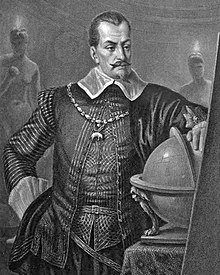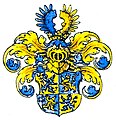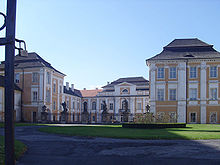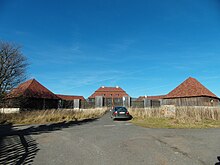Waldstein (noble family)

The Waldstein ( Czech Valdštejnové , also z Valdštejna ) are an old Bohemian lordly family from the Markwartinger clan (Markvartici) with the ancestral home of Burg Waldstein near Turnau , which is documented with Marchwart von Waldstein, camerarius, 1159 (Privilege Book of the Waldsassen Monastery , No. 171 , fol. 38 b) was mentioned for the first time and, according to the Bohemian gentry order of 1501, took 11th place among the old gentry families.

The most famous member of the Waldstein family, Albrecht Wenzel Eusebius Freiherr von Waldstein, called Wallenstein , was appointed imperial count on September 12, 1622 . Additional titles were added to the Grand Palatinate and the title “Ruler of the Waldstein House” at the beginning of 1623, Imperial Prince “von Friedland” (primog.) At the end of 1623, Bohemian prince since March 13, 1624 and the enfeoffment with the Duchy of Friedland (as a fiefdom of the Bohemian Krone) on January 4, 1627, the Duchy of Mecklenburg on January 26, 1628, the Duchy of Sagan and (as a pledge) the Duchy of Glogau on February 16, 1628.
The von Waldstein family owned extensive manors in Bohemia and Moravia and had represented representatives in the state government and administration since the 16th century. After the coats of arms union with the Lords of Wartenberg in 1758, the name is also Imperial Counts of Waldstein and Lords of Wartenberg .
history

The Waldsteiners, like the von Lämberg , Michaelsberg , Welesin , Dietenicz, Zwirzeticzky and Wartenbergs, come from the house of the Markwartinger . Members of this widespread family, documented since 1059, residing in the north and northeast of Bohemia, were influential personalities at the court of the Přemyslid dynasty in Prague.
The first known bearer of the predicate of origin "von Waldstein", Zdeněk von Waldstein (1242–1278), was the son of the royal burgrave on Jungbunzlau , Jaroslav von Hruštice (1198), from whom the castle Waldstein as a manor on three rocks in the forest south of Turnau was built and is still in ruins today. The predicate name comes from this castle . Zdeněk is said to have gone to war against the Pruzzen at the side of King Přemysl Ottokar II together with his twenty-four sons (according to other information there were six sons) .

After his death, the property was divided and the family branched out into several lines, which were named after the respective seat of power. The headquarters of the Waldsteiners were in Lomnitz , Stephanitz , Pirnitz , Groß Skal , Aujest , Hostinitz , Bílé Poličany , Miletin , Münchengrätz , Dobrowitz , Arnau , Böhmisch Hermannitz , Jettenitz and Dux . The richest branch was probably the Moravian "Waldstein from Pirnitz" ("Valdštejn z Brtnice").
The name Waldstein has been used in public life since the 15th century. Members of the family became high clergymen and scholars, the military, governors of the Bohemian districts, appointed assessors at the regional and chamber courts and took over high court offices such as chamberlain , chief judge , chief mint master and chief precutter up to the office of the upper castle count and governor of the Kingdom of Bohemia. The best-known representative of the family, Wallenstein , came from a side branch with fewer than 100 inherited and taxable farmers in the small manor of Hermanitz on the Elbe .
Fortune and property that the family had acquired in Bohemia and Moravia since the Middle Ages were confiscated after the Battle of the White Mountain, at least from those parts of the Waldsteiners who were close to the Bohemian aristocracy and who were close to the Protestant faith, and mostly bought up by Wallenstein. In the middle of the 18th century the side branches were extinct except for the lines in Münchengrätz and Dux or, if Protestant, emigrated. The family took on the name Waldstein-Wartenberg in 1758 after the extinction of the Lords of Wartenberg, with whom they had common ancestors.
Descendants of the family still hold castles in the Czech Republic or litigate for their return. In Austria the hunting lodges Schloss Karlslust and Idolsberg belong to the family.
coat of arms
- The main coat of arms of the Markwartinger shows a walking lion, a coat of arms of the Waldstein ancestor Jaroslav von Hruštice (seal from 1237). The Waldsteiners originally had, like all the other margraves , a single blue lion, double-tailed , in the golden field in the coat of arms. In 1337 the lion was drawn upright.
- In the 16th century the shield was quartered gold and blue , in 1 and 4 a red-tipped, red-armored blue lion, in 2 and 3 a red-tipped, red-armored golden lion. In the Moravian family branches all the lions looked to the right, in the Bohemian branch the lions looked at each other. A crown was later placed on them. Adam von Waldstein received the imperial eagle from Emperor Rudolf II for his coat of arms , which held an anchor and a palm branch in its claws, surrounded by a laurel wreath. After the murder of Wallenstein , the family was allowed to keep the ducal coat around their coat of arms.
Family branches
Branch Pirnitz (Brtnice)
The line of Moravian Waldsteiners founded Zdenek's grandson Botho von Waldstein (Půta z Valdštejna) († 1355). His descendants owned estates in Pirnitz , Ruckstein , Ungersberg and Mährisch Budwitz . Members of the family held high state offices: state governors were, for example, Hachek (Hašek) († 1425), Burian († 1544), Zdenek (Zdeněk) († 1564) and Heinrich (Jindřich) († 1589). Hynek von Waldstein became chief chamberlain in 1588.
The last representative of this line was Zdenek von Waldstein auf Pirnitz (Zdeňek z Valdštejna na Brtnici) († 1623), one of the richest Moravian nobles of his time. He was educated at the universities in Strasbourg and Orléans and took part in the uprising from 1618 to 1620 as a member of the board of directors of the Estates government . The chamberlain of the winter king Friedrich V was arrested after the battle of the White Mountain in Iglau and sentenced to death, but the sentence was later softened by the emperor to life imprisonment. Zdenek died in the Špilberk fortress in Brno . In 1623 his three dominions were divided among Catholic nobles. Pirnitz went to Rambold XIII. von Collalto , Ungersberg to Thomas Cerboni and Mährisch Budwitz to Hannibal von Schaumburg.
Dobrowitz branch (Dobrovice)
The estate in Dobrowitz fell to the Waldsteiners after Heinrich von Waldstein married Anna von Wartenberg in 1545 . The rich widow of the burgrave Johann von Dohna bought the village and the Dobroviceves rule, her son Heník (1568–1 May 1623) enlarged the estate and had Dobrowitz named town. After all, the rule was one of the largest in the Jungbunzlau area . A Latin school was founded in the city and a printing press was set up in the castle in 1610. In 1616 Heník published a pamphlet in which he attacked Emperor Rudolf II and King Matthias . He was summoned to court. So that he could not be convicted, he had the witness, the printer Mizera, secretly executed. The act was discovered and Heník had to pay the emperor a fine. Finally he fled to Saxony and died in Dresden under mysterious circumstances; he is said to have been poisoned with his wife. The only son Heinrich was shot in Dresden when he was eighteen. Albrecht Wenzel Eusebius von Waldstein received the confiscated property . The estate, about 50,000 hectares, remained in the family until 1734, when it came into the hands of the Fürstenberg family through another marriage .
Branch Dux (Duchcov)
Maximilian († February 18, 1655) married the widow of Franz Josef Popel von Lobkowitz , Polyxena von Talmberg , who brought her husband's inheritance into the marriage, including Münchengrätz , Valečov , Klášter Hradiště nad Jizerou , Dobrowitz, Loučeň , Zvířetice , Stauding , Großskal, Kněžmost and Duchcov . As a result, the fortunes of the Waldsteiners continued to grow considerably.

Maximilian's youngest son and heir to Dux Castle was Johann Friedrich von Waldstein Bishop of Königgrätz and Archbishop of Prague. He was ten years old when he took over the family inheritance. In 1664 he confirmed the town privileges to the residents of Dux. In 1671 he had a brewery built in Dux and made it easier for his subordinates to labor. The city was allowed to keep the income from taxes. The administration was given into the hands of the citizens. Johann Friedrich also called numerous artists to Bohemia, including the French architects Jean Baptiste Mathey , Marc Antonio Canevalle and Giovanni Domenico Orsi de Orsini , who worked on his buildings in Dux, Oberleutensdorf, Obergeorgenthal and Prague. Other personalities were also guests, such as Captain Kilian Ernst Miebes and his confessor Johann Christoph Heymann . The construction activities led to the establishment of suppliers such as brickworks and lime kilns.
Johann Friedrich died in 1694, whereupon his brother Ferdinand Ernst Josef took over the rule of Dux. His son Johann Josef von Waldstein inherited the property in 1707. His Dux property was bequeathed to his nephew Franz Josef in 1731. He was also a patron of culture, who during his reign supported artists like Benedikt Wurzelbauer , who created a Venus fountain in Dux (now in the Wallenstein Palace in Prague), but also Matthias Bernhard Braun or the Dux sculptor Matthias Kühnel . He had the plague column of the Holy Trinity built in Dux, which is still standing on the town hall square today. In 1758 he inherited the coat of arms and the name of the Lords of Wartenberg .
Emanuel Philibert von Waldstein (February 2, 1731-22 May 1775) took control of the area in 1760. For his wife Maria Anna Theresia of Liechtenstein he was in the Ore Mountains near the town Fleyh the hunting lodge Lichtenwald built. In Dux he set up a stocking factory and under his reign the first Holy Trinity coal mine was put into operation.
He was succeeded in 1774 by his first son Josef Karl Emanuel (February 16, 1755– March 17, 1814), who, like his ancestors, were great lovers of the arts and science. In 1785 he invited the globetrotter and philosopher Giacomo Casanova to his castle in Dux, who worked here as a librarian for 13 years and wrote most of his literary works. But Friedrich Schiller , Johann Wolfgang von Goethe , as well as the composer and friend of his brother Ferdinand Ernst , Ludwig van Beethoven , were among his guests. Ludwig van Beethoven dedicated one of his piano sonatas , which are still widely played to this day and which became and is popular under the title of the von Waldstein family. After the Battle of Kulm, he entertained the Russian Tsar Alexander I and his brother Konstantin Pawlowitsch Romanow , the Prussian King Friedrich Wilhelm III. , Austrian Chancellor Metternich , Prince Schwarzenberg and Marshal Josef Wenzel Radetzky von Radetz .
After Josef Karl Emanuel's death in 1814, his son Franz Adam von Waldstein took over the inheritance. He was originally a soldier, later an important researcher and botanist. Franz Adam bequeathed his herbarium to the National Museum in Prague, which he put together on his travels. He was followed by Ferdinand Ernst von Waldstein , Lieutenant General of the British Army and Commander of the Teutonic Order in Virneberg and Georg Josef (April 11, 1768– April 26, 1825).
Anton (* July 11, 1793; † March 13, 1848), first born son of Georg Josef, was one of the last important Waldsteiners of the Dux family. He expanded the library, which was visited by František Palacký , among others , with 22,000 volumes. Frédéric Chopin was one of his guests who gave their concerts here . In 1835 he organized a large military parade in honor of the monarchs of Germany and Russia. In 1838 he was offered the title of prince, but since the German money nobility meant nothing to him, he replied with the words Better an old Bohemian count than a young German prince .
The Dux branch of the Waldsteiners died out in 1901.
Branch Jettenitz (Dětenice)
Wallenstein acquired Jettenitz in 1622 from the confiscated property of an insurgent family from the Bohemian Chamber and later sold it to his relative Adam von Waldstein, a descendant of Hašek von Waldstein († 1452 or later), military leader in the Hussite Wars and governor of Moravia and the County of Glatz . In the 18th century it happened through family marriage.
Branch Lomnica (Lomnice)
The first representative of this branch was Johann Skalsky von Waldstein auf Horschitz (Jan Skalský z Valdštejna na Hořicích) († 1506). The son of Henik and owners of the farms Swijan and Semil and the rock castle Vranov and Burgfriedstein counts with Zdenek of the founders of sex. His sons Wilhelm (Vilém) († 1557) and Zdenek (Zdeněk) († 1525) founded the branch of the "Waldstein von Lomnitz und Hostinetz". The "Hostinitzer" died out in 1634 with their most famous representative, Wallenstein . Today's Baroque Lomnitz Castle was only built in 1737 by the Morzin family.
Stephanitz branch (Štěpanice)
Burg Stephanitz Castle (municipality of Benecko ) was founded in the second half of the 13th century by the Lords of Waldstein and was first mentioned in writing in 1304 when it belonged to Jan von Waldstein. It began to deteriorate from the beginning of the 16th century and is now a ruin.
Henning von Waldstein (Hynek Goldenstein) († 1427) from the Stepanitz branch fought on the side of the Hussites in 1420 near Vyšehrad and 1426 near Aussig . He originally held the Goldenstein ( Koldštejn ) castle in northern Moravia, built the Vranov castle in 1414 and was one of the leading politically active representatives of the Prague Utraquists (Chalice Brothers). He campaigned for the establishment of the Polish king as King of Bohemia. In 1427 he was killed in Prague while trying to take the city for the Polish prince Sigismund of Korybut.
Other possessions
For the first time in the 14th century and again from 1630 to 1821, the Hrubá Skála Castle was owned by the Waldsteiners. They owned the manor and castle Mnichovo Hradiště (Münchengrätz) from 1623 to 1945; Wallenstein had acquired it and sold it to his nephew Maximilian in 1627. The Waldstein Palace in Prague was built for Wallenstein in 1623-30, confiscated after his murder in 1634, but later bought back by Maximilian and remained in the family's possession until 1945. Wallenstein also acquired the rule of Bělá pod Bezdězem (Weißwasser) in 1622; after his death it was confiscated, but bought back by Count Ernst von Waldstein in 1678 and also kept by the family until 1945; White water included the Kuřívody manor (chicken water). Jicin , with the built by Wallenstein Royal Palace, the family went to his death, like most of his other possessions, including Schloss Friedland , Castle Reichenberg and the Silesian Duchy of Sagan , lost again (see: Duchy of Friedland ).
Hirschberg remained in the family's possession for a long time. Horní Litvínov (Oberleutensdorf) came in 1642 from the Lobkowicz by marriage to the Waldstein, together with Niederleutensdorf , Niedergeorgenthal and the Dux lordship , with whom these properties were merged to form a family entourage. At the end of the 17th century, the Counts of Waldstein had a manor house built in place of the old fortress based on plans by Giovanni Domenico Canevalle. Třebíč Monastery was secularized and converted into a castle, and in 1582 it came to the Waldstein family. Karlslust Castle in the Waldviertel (Lower Austria) was inherited in 1945 by the Counts of Waldstein-Wartenberg, who at the same time also became the owners of the estate in Niederfladnitz with the associated Kaja Castle , which they still own today.
Jičín Castle on the right
Other well-known personalities
- Leonore von Waldstein (⚭ 1239 Konrad von Kottwitz), her husband was with Emperor Friedrich II in Syria
- John VI von Waldstein († 1311), Bishop of Olomouc
- Hašek von Waldstein († around 1452), military leader in the Hussite Wars
- Benedikt von Waldstein (~ 1440–1505), Roman Catholic clergyman, Bishop of Cammin
- Johann (Jan) († June 15, 1576) was the chief judge in Bohemia from 1554–1570 and chief treasurer until 1576. He was a supporter of the utraquist faith.
- His son, Burgrave Adam the Younger of Waldstein on Komorní Hrádek, Sasau, Lobositz, Dobrowitz, Rožďalovice and Trebitsch (June 8, 1570– August 24, 1638), was appointed supreme court judge in 1611 and in 1611–1619 the chief steward. He was a loyal supporter of the emperor. For this he was awarded further hereditary estates in 1621. In 1628 he was appointed Reichsmarkgrave, from 1627–1638 he was the highest margrave . He himself viewed this honor with mixed feelings. As a Bohemian nobleman, he represented the old Bohemian royal rights, which only knew the gentry and knighthood. He justified the rejection of the increase in the rank of imperial counts with the pride of belonging to the Bohemian nobility. It was his wish to be allowed to die as a Bohemian gentleman.
- Hans Christof von Waldstein, 17th century landlord of Arnau on the Elbe
- Ladislaus Burian Count von Waldstein (Ladislav Burian) (1591–8 October 1645 in Prague) was an army commander.
- Zdenek von Waldstein (? –1623) on Pirnitz (Czech. Na Brtnici) (mentioned in 1591 as a house buyer in Arnau (next to the town hall))
- Ferdinand Rudolph von Waldstein (1628–1687), Imperial Chamberlain
- Ernst Joseph von Waldstein (1654–1708), governor of Bohemia
- Karl Ernst von Waldstein (Karel Arnošt) (born May 4, 1661 in Vienna; † January 7, 1713 ibid) was the ambassador of the Austrian crown in Spain , Savoy and Brandenburg . When he returned from a diplomatic mission in France and Portugal on a Portuguese ship in 1703, he was captured by the French and imprisoned for almost a year in a state prison in the Donjon of Vincennes . There was an exchange of prisoners against the French Marshal François de Neufville, duc de Villeroy .
-
Leopold von Waldstein (1677–1748), diplomat, emperor. Envoy in Dresden, Governor of the County of Glatz
 Ferdinand Ernst von Waldstein-Wartenberg
Ferdinand Ernst von Waldstein-Wartenberg
(1762–1823), KuK Privy Council, Kgl. British general and friend of Beethoven - Joseph Octavian von Waldstein (1680–1722), governor of Moravia
- Franz von Waldstein (1709–1771), Kaiserl. Really secret advice
- Ferdinand Ernst von Waldstein-Wartenberg (1762–1823), KuK and Kurkölner Privy Council , Kgl. British general and friend of Beethoven
- Emmanuel Ernst von Waldstein (1716–1789), was Bishop of Leitmeritz
- Johann Friedrich von Waldstein-Wartenberg (1756–1812), Bishop of Seckau and Archbishop of Prague
- Franz Adam von Waldstein-Wartenberg (1779–1823), Austrian botanist
- Adolf von Waldstein (1868–1930), KuK Chamberlain and Privy Councilor, Obersterbland Vorschneider of the Kingdom of Bohemia , erbl. Member of the manor house of the Austrian Imperial Council
- Angelus Waldstein (* 1931), actually Karl Albrecht von Waldstein , took on the name Pater Angelus when he entered the order. He is a monk of the Benedictine Abbey of Ettal and prior of the Wechselburg monastery.
- Margarete von Waldstein-Wartenberg ( Daisy Waldstein-Wartenberg * 1926 in London) in the Czech Republic 2007 woman of the year, engaged in the Malteserhilfsdienst
- Georg Waldstein-Wartenberg (* 1942 in Buchberg am Kamp) Austrian business journalist and publisher
literature
- Constantin von Wurzbach : Waldstein, the counts, genealogy . In: Biographisches Lexikon des Kaiserthums Oesterreich . 52nd part. Kaiserlich-Königliche Hof- und Staatsdruckerei, Vienna 1885, pp. 208–210 ( digitized version ).
- Constantin von Wurzbach : Waldstein, the counts, property and coat of arms . In: Biographisches Lexikon des Kaiserthums Oesterreich . 52nd part. Imperial-Royal Court and State Printing Office, Vienna 1885, p. 228 f. ( Digitized version ).
- Roman von Procházka : Genealogical handbook of extinct Bohemian gentry families , Neustadt an der Aisch, 1973, ISBN 3-7686-5002-2 , there: Friedland zu Mecklenburg family of families from Waldstein, with numerous other references, page 91/92.
- The coats of arms of the Bohemian nobility , J. Siebmacher's big coat of arms book, Volume 30, Neustadt an der Aisch, 1979, ISBN 3-87947-030-8 , there: Counts of Waldstein-Wartenberg, page 184 and coat of arms panel 79; Counts of Waldstein, page 267, coat of arms 123.
- Pavel Koukal: Duchcov v zrcadle dějin (Dux in the mirror of history) . Duchcov: Kapucín, 2005. ISBN 80-86467-10-4 .
- Zdislava Röhsner: Wallenstein and much more. 850 years of the Waldstein family . Fassbaender Verlag, Vienna 2009.
Footnotes
- ↑ ... but Konrad v. Kottwitz did a lot of credit to his family. It is he who is with kays. Friedrich II. Ao. 1239 came happily from Syria to Vienna, and with the baron Leonoren v. Waldstein was married, but died in his 76th year of age. Page 365 in Lausitzer Magazin or a collection of various treatises and news .... Third year 1770, Görlitz bey Joh. Friedr. Shearers
Web links
- Stanislav Kasík: The Waldsteiners. In: Waldsteiner picture gallery in the Egerer Museum - catalog for the permanent exhibition. Eger 1999 (PDF file; 2.72 MB)
- Ancestral sample of Ferdinand Ernst Joseph Graf von Waldstein and Wartemberg at monasterium.net
- The Wallenstein coat of arms and the imperial diplomas awarded to it by Maximilian Gritzner , in 1880 in the "Vierteljahrsschrift für Heraldik, Sphragistik und Genealogie" in Berlin
Individual evidence
- ↑ Peter Ritter von Chlumecky: Carl von Zierothin and his time 1564 to 1615 . A. Nitsch, Brno 1862.
- ↑ Genealogical Handbook of the Nobility, Volume GB IV, Ancestry of the Counts Magnis, page 452, CA Starke-Verlag, Limburg, 1973
- ^ Genealogy. Handbook of the nobility, volume G XV, page 539, CA Starke-Verlag, Limburg, 1997
























